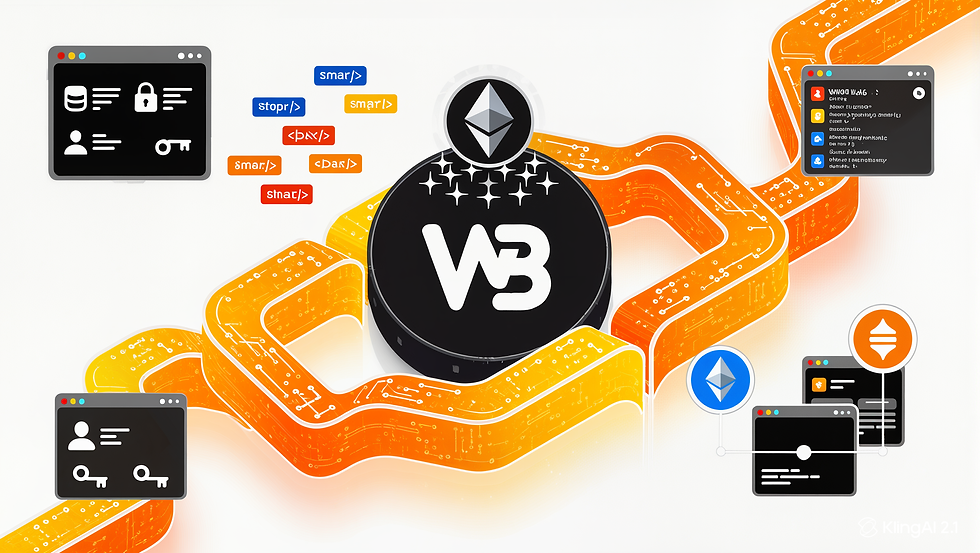What is Web3? Understanding the Difference Between Web3 and Web 3.0
- rachelbeautybar

- Aug 2
- 3 min read
If you’ve been following blockchain or cryptocurrency discussions, you’ve probably heard the term Web3 thrown around. But What is Web3? And how is it different from Web 3.0?

While many people use Web3 and Web 3.0 interchangeably, they are not the same. This guide breaks down the concept of Web3, its key components, how it differs from Web 3.0, and why it’s considered the next phase of the internet.
What is Web3?
What is Web3? Web3 describes the vision for a new generation of the internet—one that is decentralized, open-source, and built on blockchain technology.

Unlike the current Web 2.0 model dominated by centralized platforms and data silos, Web3 shifts power back to users by enabling peer-to-peer interaction without relying on intermediaries.
Data in Web3 is stored on decentralized blockchain networks, removing control from centralized authorities and allowing users to directly own and control their digital identity and assets.
The term “Web3” was first introduced in 2014 by Gavin Wood, co-founder of Ethereum, to describe this user-owned, blockchain-powered internet.
Web3 vs Web 3.0: Key Differences
Although both aim to create a better internet, Web3 and Web 3.0 are fundamentally different in focus and technology.
1. Core Objective
Web 3.0 (Semantic Web): Focuses on making data more efficient and machine-readable to create a smarter, more interconnected internet.
Web3 (Decentralized Web): Focuses on security, user ownership, and decentralization by removing reliance on central authorities.
2. Technology Stack
Web 3.0: Built on traditional client-server architecture using HTTP/HTTPS and semantic technologies like RDF and SPARQL.
Web3: Built on blockchain protocols and decentralized networks.
3. Data Management
Web 3.0: Uses centralized systems like Solid Pods to store user data.
Web3: Uses crypto wallets and private keys to manage and secure user identity and assets on decentralized networks.
4. Security
Web 3.0: Data stored in centralized pods can still be altered or censored.
Web3: Blockchain’s immutable nature prevents tampering or deletion, ensuring transparency and trust.
Key Components of Web3

Blockchain: The backbone of Web3, enabling decentralized data storage and transactions.
Smart Contracts: Self-executing programs that automate agreements without intermediaries.
EVM (Ethereum Virtual Machine): The computation engine that runs smart contracts on Ethereum and compatible networks.
Front-End Interfaces: User-facing applications built with Web3 libraries (Web3.js, Ethers.js) that connect to decentralized networks.
How Web3 Works
Web3 operates using four main technology layers:
Edge Computing: Moves processing power to the user side instead of centralized data centers.
Decentralized Data Networks: Gives users ownership of their data without relying on third-party platforms.
AI and Machine Learning: Enhances automation and personalization within decentralized systems.
Blockchain: Provides secure, immutable, and trustless infrastructure for all transactions and data.
Instead of relying on centralized servers like Web 2.0, Web3 applications run on distributed networks where smart contracts execute logic, ensuring fairness and transparency without intermediaries.
Advantages of Web3
High Decentralization: Reduces reliance on corporations or governments.
Peer-to-Peer Interaction: Users can transact directly without banks or third parties.
User-Owned Data: Individuals have full control over their personal information and digital assets.
Crypto-Native Payments: Web3 integrates digital currencies and blockchain-based payment systems seamlessly.
Transparent and Trustless: All interactions can be verified on-chain.
Challenges of Web3
Scalability: Current blockchain infrastructure struggles with speed and cost compared to Web 2.0.
User Experience: Wallet setup, private key management, and interaction with dApps are still complex for beginners.
Accessibility: Lack of integration with familiar Web 2.0 platforms limits adoption.
Development Costs: Building secure decentralized applications can be expensive due to audits and gas fees.
Real-World Applications of Web3

Data Ownership: Users can control and monetize their personal data.
Healthcare: Patients can securely share medical records while maintaining privacy.
Education: Decentralized learning platforms can issue verifiable blockchain-based certificates.
Finance (DeFi): Web3 enables decentralized lending, borrowing, and trading outside traditional banking systems.
Digital Art & NFTs: Creators can directly monetize their work without intermediaries.
DAOs: Community-governed organizations built entirely on blockchain.
Conclusion
So, What is Web3? It’s a vision for a decentralized, blockchain-powered internet that hands control back to users. While Web3 and Web 3.0 share a common goal of improving the internet, their approaches are vastly different.
Web3’s focus on decentralization, data ownership, and blockchain integration positions it as a driving force for the next digital revolution. Though still in its early stages, Web3 holds the potential to reshape industries, empower users, and create a fairer online economy.
Register by the links below to get cashback fees up to 70%:

Comments